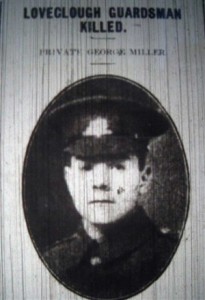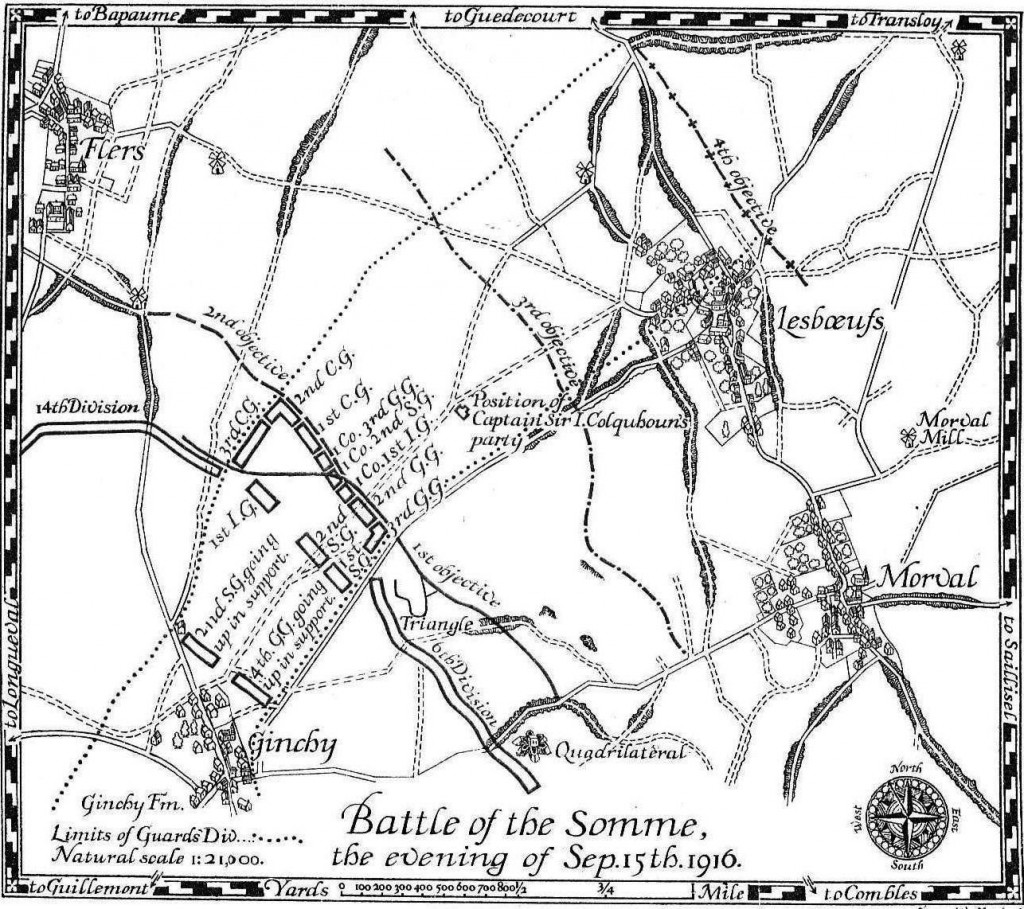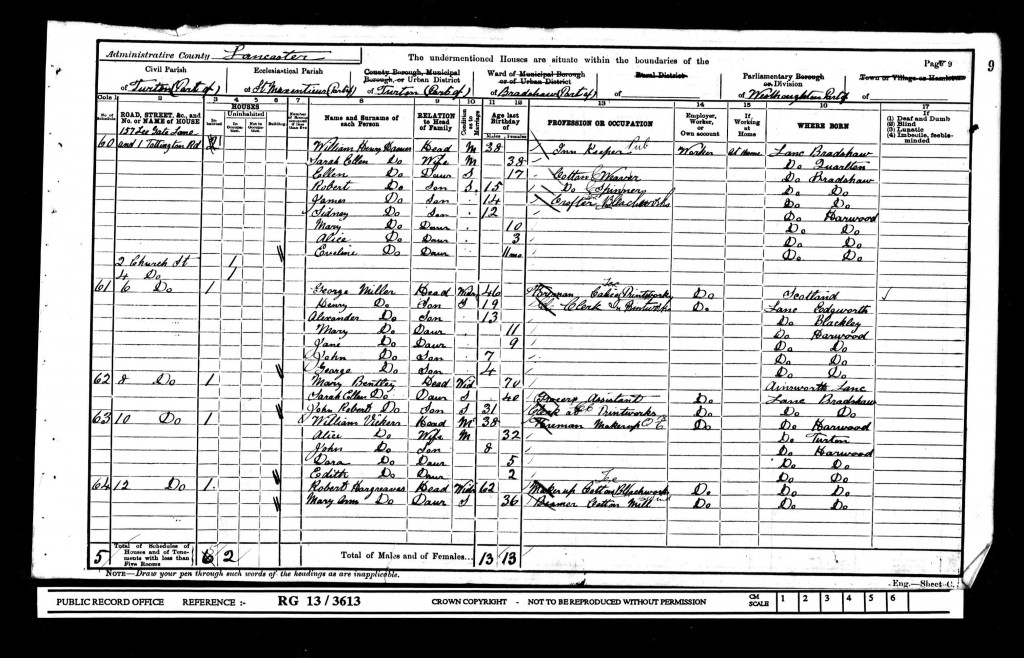Private, 13509 3rd Coldstream Guards.
Lived on Burnley Road, Crawshawbooth.
Died of Wounds 16th September 1916, aged 19.
Buried La Neuville British Cemetery, Corbie, France.
 George was one of eight children, five brothers and two sisters, he came to Loveclough from Bolton around 1912, and was born in the Bradshaw area of Bolton to George senior and Mary Jane and they lived for a time at Bramhall Lancs. George worked at Loveclough Print works prior to the war, a large mill (now a private housing estate) at the bottom of Commercial Street, which is in turn, opposite the old National School. He lived on Burnley Road in Loveclough and on enlisting in November 1914 at Rawtenstall he joined the Coldstream Guards 3rd Battalion, regimental number No 13509 disembarking overseas on the 11th June 1915. He had seen much fighting and was a participant in the Battle of Loos in the autumn of 1915.
George was one of eight children, five brothers and two sisters, he came to Loveclough from Bolton around 1912, and was born in the Bradshaw area of Bolton to George senior and Mary Jane and they lived for a time at Bramhall Lancs. George worked at Loveclough Print works prior to the war, a large mill (now a private housing estate) at the bottom of Commercial Street, which is in turn, opposite the old National School. He lived on Burnley Road in Loveclough and on enlisting in November 1914 at Rawtenstall he joined the Coldstream Guards 3rd Battalion, regimental number No 13509 disembarking overseas on the 11th June 1915. He had seen much fighting and was a participant in the Battle of Loos in the autumn of 1915.
George was wounded in a further attack a year later, in the Multidivisional attack that included the Guards Brigade on the 15th of September 1916 at a village called Ginchy in Northern France, the same day that Tanks were used for the first time. George was evacuated to No 21 Casualty Clearing Station at La Neuville, a suburb of Corbie where he subsequently died from his wounds the next day on the 16th September 1916.
He is buried in Plot 2 Row E Grave 52 in La Neuville British Cemetery, at the base of his headstone chosen by his family reads the words, He Laid His Richest and Best Gift, His Life, Upon the Altar of Duty. George was aged just 20 years.
La Neuville is a suburb of Corbie separated by the Railway Line from Amiens to Albert and was close to the broad gauge railway line so that ambulance trains could be brought up direct to 21 C.C.S and evacuate men without using motor ambulances.
Brief history on 21 C.C.S. 21 Casualty Clearing station began with Lieutenant Colonel Clements reporting to Aldershot on July 25th 1915, and met his Officers detailed for personnel of the newly formed 21C.C.S. They sailed for Le Havre from Southampton at 5pm on the 27th of July 1915 aboard the British India S.S.Cheybassa.
Suffering a wet and stormy crossing they landed at Le Havre at 10.45 the next day and stayed at Le Havre until the 25th of August. After a day in Rouen, where they drew dental gear, they arrived at Corbie at 12.30 pm on the 27th of August 1915.
On the 29th of August 1915 21 C.C.S took over the Hubert Briere Factory at La Neuville under the instructions of the D.M.S third army, and spent the next two weeks repairing, cleaning,
Whitewashing, and making it fit for its purpose. The War Diary extract for No 21 C.C.S for September1916 reads.
September 13/1916
Received Operation order No8 D.M.S Fourth Army
This C.C.S will be held in reserve until required from midnight.
14/15th September (weather showery) No patients evacuated today.
September 16th (date of George Millers Death) Number of patients evacuated today is.
Officers 24
Other ranks 462
They pushed forward to the Brown Line from which the enemy had evacuated. Consolidation was begun about 6.pm. and the enemy made a counter attack, which was easily repulsed.
After dark, rations of water and ammunition were brought up.
Total Casualties,
Officers 11
Germans 17
Total admissions for the whole of September are,
Officers 447
Other ranks 6,481
Germans 176
September total being 7,104.
Also a point of note, is during the 3rd Battalion Coldstream’s attack, Lt Col John Vaughan Campbell won his Victoria Cross, his citation says..
“Seeing that the first two waves of his Battalion had been decimated by machine gun and rifle fire, he took personal command of the third line, rallied his men (this he did with the aid of a hunting horn!) and led them against the enemy machine guns, capturing the guns and killing the personnel” later in the day after consultation with other unit commanders, he again rallied the survivors.
This action became known by some as the Tallyho V.C
War Diary Extract
1st Guards Brigade
3rd Battalion Coldstream Guards September 15th 1916.
At 6a.m. the K.O.Y.L.I and 1 Tank advanced on our left to clear our position on the left flank where the situation was somewhat obscure.
At 6.20 the assault was launched and the Battalion went over in four half-company waves at 50 pace intervals.
The attack was met with great opposition from the sunken road about 300 yards from our trenches, after this, the Green Line (an objective that day) was taken without much opposition. Here the Battalion re organised, and then pushed forward to the Brown Line, from which the enemy had evacuated. Consolidation was begun about 6.p.m., and the enemy made a counter attack, which was easily repulsed. After dark, rations of water and ammunition were brought up. The Map below shows the area of the limit of the attack made by the Guards on the 15th September and shows the respective Battalion positions that evening. A further attack was made on the 25th 0f September by the Guards again, capturing Lesbouefs.
.
Total Casualties were, Officers 11, Other Ranks 414, one of which was George Miller. The Picture below is of Pte George Miller’s Headstone in La Neuville British Cemetery France, with his family’s chosen words at the foot of the stone.
Below is the 1901 Census for the Bradshaw area of Bolton( please click on image to enlarge) where George lived with his widowed father, and his brothers and sisters. His Father’s occupation is given as a printer in a calico Printworks, given that Loveclough Printworks had a massive fire around 1905, it looks like on refurbishment of the mill there may have been a staff shortage and prompted the Millers to settle in Loveclough around George seniors workplace. Incidentally the 1911, Census reports the Millers living at 17 Rigby Lane Bromley Cross, his father had re married a lady called Esther, and had two sons with her, Georges occupation at 14 years old was a labourer in a Varnish Manufacturer
The illustration is that of the Coldstream’s famous charge on the 15th of September 1916 around the village of Ginchy towards Lesbouefs.

La Neuville British Cemetery , George Millers final resting place.
